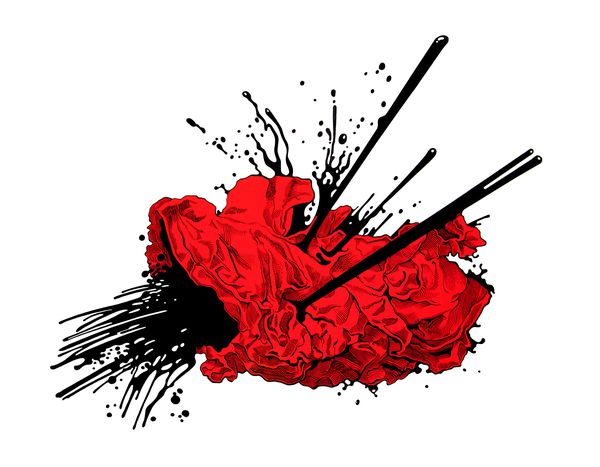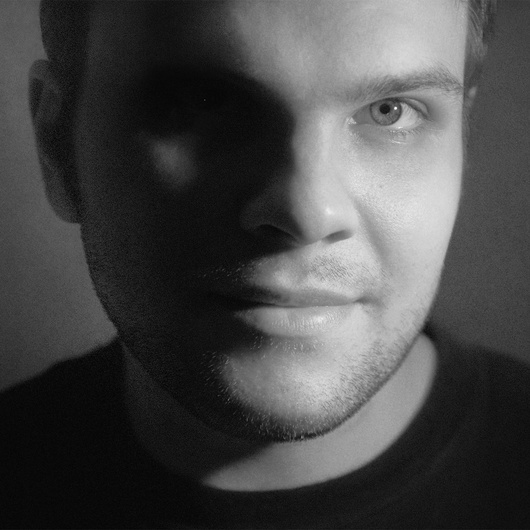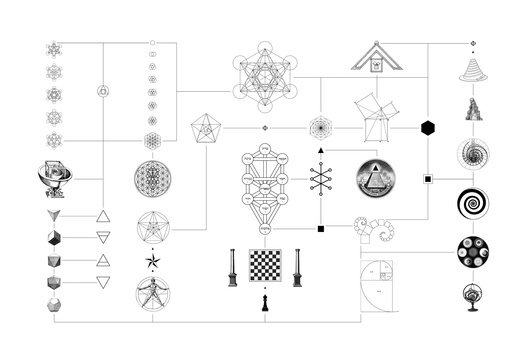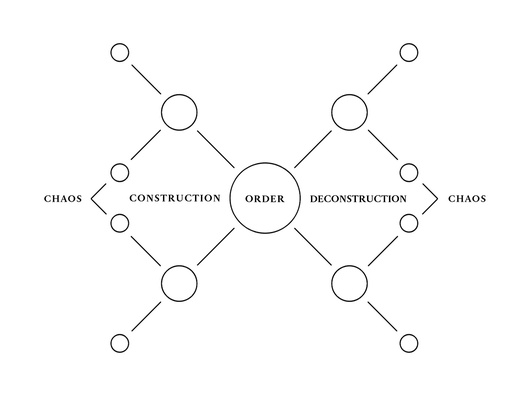
Polish artist Kuba Woynarowski on art, chaos and narration
Published on
Translation by:
Veronica MontiCafébabel embarks on a philosophical journey on the narrative potential of art with the Polish artist Jakub Woynarowski.
Along the way, we stop off at conspiracy theories, connections and narrations arising from chaos.
Spring peeks out among Krakow's majestic cathedrals while I wait for Jakub (Kuba) Woynarowski, one late morning at the end of March, in the centre of the city. It's a warm and gentle day. The buildings that looked so austere in the winter now seem to smile. At about 11 am, Jakub arrives. He has a sweet smile that suits this mild and pleasant day. After pleasantries, we quickly start talking about art.
cafébabel: In your presentation at one point you talk about conspiracy theories and the importance they have for you. What do you mean?
 Kuba: The key word here is "connection". I see the world, life, as a system of connections. Today with the advent of Internet and the possibility to access to such eterogeneous information the connection between disparate events and objects is very clear. Which is good in a way, because we have the possibility to listen to different voices and compare them, but on the other hand there's a risk of getting distracted, of being manipulated, of losing the narrative link. It's hard to find the right balance. The conspiracy theories are an attempt, sometimes exasperated, to connect different elements, which can sometimes leads to paranoia and madness. I do a scientific job in a way, not only artistic, when I look for these connections in the art field. Connections based on facts and research.
Kuba: The key word here is "connection". I see the world, life, as a system of connections. Today with the advent of Internet and the possibility to access to such eterogeneous information the connection between disparate events and objects is very clear. Which is good in a way, because we have the possibility to listen to different voices and compare them, but on the other hand there's a risk of getting distracted, of being manipulated, of losing the narrative link. It's hard to find the right balance. The conspiracy theories are an attempt, sometimes exasperated, to connect different elements, which can sometimes leads to paranoia and madness. I do a scientific job in a way, not only artistic, when I look for these connections in the art field. Connections based on facts and research.
cafébabel: What is the role of connection in your art?
Kuba: Art, like science, philosophy, but also common thinking, is not exempt from this system of connections. It's all about creating a narration, a story, in this chaos. Alchemy represents this concept very well. Alchemy has a very efficient visual system: the colour black represents the chaos, that is the multiplicity of possibilities, the white is the moment of selection and choice, the red is the creative moment itself. Art does that. Art creates from existing structures. It's what I do as well, when I create diagrams that seem to be finished but are not, it's an illusion. I like to re-interpret. All the elements of reality are connected between them, they are part of the same system. When I describe the human, I do it by representing his environment, his objects. In my works there are almost no human figures.
 cafébabel: In your work "Hikikomori" for example. Hikikomori, in Japanese, is a youth who isolated himself and retired from the outside world. But this artwork represents a black and red item on a white background, that seems to be pierced by sharped chopsticks, not an human being. I had a strong feeling of violence.
cafébabel: In your work "Hikikomori" for example. Hikikomori, in Japanese, is a youth who isolated himself and retired from the outside world. But this artwork represents a black and red item on a white background, that seems to be pierced by sharped chopsticks, not an human being. I had a strong feeling of violence.
Kuba: Exactly. I didn't represent an human being but you saw something human in it. Violence. Hikikomori is the representation of the fighting energy. The black and the red in this artwork are two energies struggling against each other. The item suffers. Animals, humans, items, they are all connected. Destroying an item is like perpetrating an act of violence against a human being. Especially through the absence of the human figure I can evoke his presence.
cafébabel: But why "Hikikomori", why a Japanese title?
Kuba: Because the Japanese pop culture is particularly focused on the theme of violence, even in an indirect way, sometimes. That's why I decided to recall it with this title. Of course, violence is not a feature of the Japanese culture only, but of all cultures.
 cafébabel: Other items and spaces that you represent are very detailed, on the other hand. Almost technical, almost taxonomic. Kuba: I love the Infographic language. When I was a child I used to leaf through technical handbooks. I think that the tension between precision and abstract art is very interesting. Abstract art is created by an extreme semplification of the image, but also by an obsession for the detail. Both macro and microcosms look abstract to us. Realism is in the middle of them.
cafébabel: Other items and spaces that you represent are very detailed, on the other hand. Almost technical, almost taxonomic. Kuba: I love the Infographic language. When I was a child I used to leaf through technical handbooks. I think that the tension between precision and abstract art is very interesting. Abstract art is created by an extreme semplification of the image, but also by an obsession for the detail. Both macro and microcosms look abstract to us. Realism is in the middle of them.
cafébabel: Let's go back to the connection topic. Do you think it's possible to live and create without a connection with the outside world? An hikikomori, for example, who isolated himself from the world.
Kuba: (laughing) The hikikomoris are always surfing on the Internet, though. No, I don't think it's possible. Art is kind of recycling, an use of existing structures. Every idea is the product of a system of connections. When you think and create something, you do it based on other ideas which influenced you before. Everything is in a perpetual communication with everything. Even if you produce something only for yourself and lock it in your room and don't show it to anyone. Even in this case you are communicating. You are communicating with yourself. And what you communicate is the product of other events which you were previously in communication with. Your body, your hands, become a vehicle to transmit a message.
 cafébabel: Therefore, this communication is the creation of a story, of a narration, from a reality which is otherwise chaotic. Kuba: Everything creates a story, even physics or mathematics. Oh, mathematics is an amazig narrative system. Astronomy. How can you make sure that a theory is really true on an astronomic scale? Stephen Hawking has success because he's an excellent stroryteller, because his story makes sense. The same is true for successful politicians and artists. This is true for every human field. Whoever can tell good stories wins, even if he's a liar, a cynic or a madman. "It makes sense", what a wonderful expression! In Polish we don't have such an appropriate expression (he laughs). I think I'm gonna call my next artwork "Make sense". It's a very effective expression because it highlights both the emotional and the rational side. People accept a story because they feel it makes sense, both logically and, especially, emotionally.
cafébabel: Therefore, this communication is the creation of a story, of a narration, from a reality which is otherwise chaotic. Kuba: Everything creates a story, even physics or mathematics. Oh, mathematics is an amazig narrative system. Astronomy. How can you make sure that a theory is really true on an astronomic scale? Stephen Hawking has success because he's an excellent stroryteller, because his story makes sense. The same is true for successful politicians and artists. This is true for every human field. Whoever can tell good stories wins, even if he's a liar, a cynic or a madman. "It makes sense", what a wonderful expression! In Polish we don't have such an appropriate expression (he laughs). I think I'm gonna call my next artwork "Make sense". It's a very effective expression because it highlights both the emotional and the rational side. People accept a story because they feel it makes sense, both logically and, especially, emotionally.
cafébabel: Do conspiracy theories "make sense"?
Kuba: Ah, the conspiracy theories, of course. They usually seem rational, but in reality they are based on beliefs.
cafébabel: So do you think that the purpose of art is to create a story?
Kuba: Art is a visual philosophy. It has always been. Another thing which I find annoying is this dominant theory of the historians of art, according to which there is a drastic breach between a beautiful and harmonious past and an ugly and evil modernity. Robert Fludd represented an abstract black square, very similar to those by Malewicz, in 1617 already. Abstract art has always existed. The intervention of craftmen during the construction of artworks is nothing new. A movement called "Incoherent Arts" in the 1880s was already doing things that have been introduced later by the Avant-Gardes, but they are not mentioned at all by the historians of art because they did it "for fun", and according to art critics, this should exlude them a priori. They think one must always be serious. It doesn't make sense to me.
cafébabel: So what we are learning in our textbooks is misleading?
Kuba: It is, when it overlooks deliberately some historical facts and gives a questionable interpretation of the historical reality. This is a narration too, but based on manipulation and oversimplification of the events.
cafébabel: Can you think about an objective reality, or universe, beyond humans and their narrations?
Kuba: [thinks for a moment] No, I can't imagine an universe without people. Because I am a person, I think, live and create as a person. We can't avoid this vicious circle.
Translated from "It makes sense": Kuba Woynarowski tra arte, caos e narrazione



